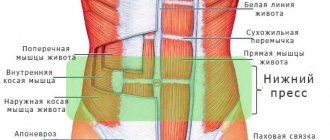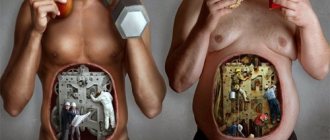What is metabolism
Metabolism is a complex of chemical reactions that occur in the cells and intercellular fluid of the body. Thanks to the constantly operating metabolism, human life is maintained. Metabolism allows the body to develop, reproduce, maintain all its functions and adequately respond to the influence of the external environment. Proteins, fats, carbohydrates and many other elements take part in this complex chemical process, each of which plays a special role in metabolism. Metabolism occurs in the following stages:
- nutritional components enter the human body;
- they are absorbed from the digestive system, fermented, broken down into smaller components and penetrate the circulatory system;
- substances are transported, absorbed by different organs and systems, and release energy;
- decay products that the body has not absorbed are removed through the lungs, intestines, and excretory system.
What it is?
According to medical terminology, a metabolic disorder is a breakdown of connections between the biochemical chains of various elements, caused by the incorrect occurrence of one of its stages. There are 4 such stages in total:
- Supply of nutrients to the body.
- Absorption from the gastrointestinal tract, fermentation and breakdown, after which they enter the blood and lymph.
- Their redistribution throughout the tissues of the body, release of the necessary energy, assimilation.
- What is not digested (decomposition products) is excreted through sweat, the respiratory and urinary systems.
If at one of the stages something went wrong, some biochemical reaction of catabolism (cleavage, differentiation) or anabolism (synthesis) slowed down, accelerated, stopped or did not occur at all, a metabolic disorder is diagnosed.
Metabolic disease
This pathology represents changes in one of the stages of metabolism - anabolism or catabolism. The latter is the oxidation or differentiation of complex elements to the state of simple organic molecules capable of participating in anabolism - synthesis, which is characterized by energy consumption. Improper metabolism is characterized by a metabolic rate that is too slow or too fast.
A low metabolic rate means that metabolic processes are slow: over a certain time, fewer calories are burned than needed, while the transformation of nutrients into energy is also slower. Thus, a person develops problems with excess weight, since not all the calories consumed have time to be burned, instead being deposited in the form of fat folds on the body.
Accelerated metabolism is also a disorder in which a person consumes almost any food, but is not able to gain optimal weight. Useful elements and vitamins that enter the body with food are not absorbed. As a result, a deficiency of important enzymes is formed, which slows down the work of key body processes. A person with a fast metabolism often feels unwell because his immune system is weakened. This reduces the body's resistance to seasonal diseases.
Protein metabolism disorders
The pathology of protein metabolism in endocrine diseases is manifested mainly by impaired protein synthesis. These changes may be associated with a decrease in the amount of amino acids, a violation of the qualitative composition of amino acids, an imbalance in enzyme activity, deterioration in the regulation of the digestive system, etc.
Suppression of the synthesis of necessary proteins in the body is facilitated by:
- lack of growth hormone (GH deficiency);
- lack of sex steroids (hypogonadism);
- hyperthyroidism;
- hypercorticism.
Growth hormone is released into the blood by the pituitary gland. This central section of the endocrine system is part of the brain. Lack of growth hormone may be associated with hereditary factors, genetic failures or damage to the pituitary gland. The pituitary gland tissue can be destroyed by a growing tumor, a hematoma. Also, GH-producing cells can be damaged due to ischemia, hypoxia, or injury. Often radical treatment (radiation therapy, surgery) leads to growth hormone deficiency. In childhood, GH deficiency manifests itself primarily as growth retardation. In adult men, this pathology leads to a decrease in muscle mass, strength and endurance.
Hypogonadism has a similar effect on metabolism. With testosterone deficiency in the male body, the synthesis of amino acids decreases. As a result, new muscle fibers are not formed, and existing ones atrophy. A man loses muscle strength and his physique changes. There is a relatively large amount of adipose tissue, and the volume of the shoulder girdle decreases.
Thyrotoxicosis and hypercortisolism are diseases that are accompanied by increased protein breakdown. In the first case, an excess of thyroid hormones leads to increased utilization of amino acids, in the second - cortisol. With thyrotoxicosis and hypercortisolism, a man may experience severe hunger, eat a lot and still lose muscle mass. All incoming and existing proteins are used for glucose synthesis. As a result, the muscles lose volume. With thyrotoxicosis, a man usually loses a lot of weight. With hypercortisolism, weight can be stable or even increase (due to adipose tissue).
Causes
A common factor in metabolic disorders is hereditary metabolic disorders. Genetic information plays a key role in the regulation of intracellular metabolism: when genes (especially those responsible for encoding the synthesis of enzymes) are mutated, metabolic defects develop. In addition, gene (congenital) defects cause mutations in structural and transport proteins. Metabolic diseases may be associated with:
- pathological changes in the functioning of the thyroid gland;
- malfunction of the adrenal glands or pituitary gland;
- improper diet (overeating, fasting, dieting);
- failure to maintain a healthy lifestyle (bad habits, lack of exercise, etc.);
- improper sleep patterns.
Imbalance of vitamins and microelements
They manifest themselves as specific vitamin deficiencies or diseases associated with the deficiency of certain elements:
- rickets;
- endemic goiter;
- anemia from iron deficiency;
- blurred vision;
- dry skin, cracks, peeling, itching, rash;
- nervousness, irritability, convulsions;
- brittleness of hair and nails;
- tooth decay;
- fatigue, insomnia.
Symptoms can be very varied.
Symptoms
Signs of abnormal metabolism can be different, they depend on at what level the changes occur - molecular, cellular, in tissues, organs or in the entire body as a whole. Any failure of the chemical metabolic process can cause endocrine diseases, dysfunction of various organs/systems, and hormonal imbalance. Changes in the body appear gradually, so the primary symptoms are often invisible.
Metabolic disorders show a variety of symptoms, among which obesity is common. Other signs of pathology are:
- changes in skin structure;
- brittleness of hair and nails;
- swelling;
- severe weight gain or loss;
- increased appetite or lack thereof;
- the appearance of dermatological problems - skin rash, acne, etc.;
- the appearance of hypo- or hypergimentation;
- dental problems (enamel destruction);
- pale skin, swelling of the limbs, puffiness of the face;
- digestive disorders (diarrhea alternating with constipation).
Disorders of carbohydrate metabolism
The main task of carbohydrates in the body is to nourish brain cells and replenish energy. Carbohydrate compounds compensate for loss of strength due to emotional or stress. At the same time, problems with the absorption of carbohydrates, as a rule, accompany the patient for life. The main symptom of a carbohydrate metabolism disorder is weight fluctuations. If the norm of carbohydrates is exceeded, the weight increases, and if there is a shortage, it decreases. Other symptoms of carbohydrate disorder:
- involuntary trembling in the body;
- hyperactivity;
- cardiovascular diseases;
- hypertension (for obesity);
- diabetes;
- increased blood glucose levels;
- depression;
- weakness/drowsiness;
- weight loss;
- Gierke's disease;
- hypoglycemia.
Protein metabolism
Protein is the main building material in the human body. Problems with protein metabolism disorders can be caused by various pathologies. When there is an excess amount of protein, a person experiences:
- decreased appetite;
- bowel dysfunction (constipation, diarrhea);
- kidney pathology, organ failure;
- tense state of the nervous system (nervous breakdowns may occur);
- deposition of salts in tissues;
- an increase in the amount of protein in the blood plasma.
Deterioration in the digestibility of protein foods, in which a large amount of amino acids and other constituent elements accumulate in the body, becomes the cause of a number of diseases, including fatty liver, osteoporosis, obesity, and gout. With too rapid breakdown of proteins and their deficiency in the body, a person experiences:
- hypotonia, weakness;
- deterioration of the condition of the skin, hair, nails;
- rapid weight loss;
- muscle wasting;
- decreased performance;
- immunodeficiency.
Fat metabolism
The balance of fats guarantees the body the normal implementation of homeostasis. Adipose tissue contains hormones and nerve fibers. The main symptom of a fat metabolism disorder is a change in body weight. When an excess amount of a substance occurs in a person, the following occurs:
- blood problems (excess cholesterol, increased clotting);
- atherosclerosis;
- formation of stones in the liver, gall bladder;
- obesity.
With a deficiency of fats, liver function suffers, and diseases of the kidneys and other organs may develop. Symptoms of low fatty acids include:
- skin inflammation;
- hypovitaminosis;
- hormonal imbalance;
- hair loss;
- insufficient body weight.
Water exchange
Water is the most important component of homeostasis; more than half of the human body weight consists of it. Normal water balance means almost equal intake and removal of fluid from the body. Violation of this indicator can occur with the following symptoms:
- blood thickening;
- development of gastrointestinal and central nervous system diseases;
- swelling of the skin;
- dysfunction of the excretory system;
- increased blood pressure;
- decreased cardiac output, etc.
Mineral metabolism
Minerals act as biocatalysts for many physiological processes and the acidic state of the body. As a rule, stressful situations, an accelerated pace of life, an unfavorable environment, bad habits and an unbalanced diet lead to mineral imbalance. If the metabolism is disturbed due to endocrine abnormalities, the following symptoms may be observed:
- decreased immunity;
- insomnia;
- blurred vision;
- brittle nails;
- decreased libido;
- stool disorder;
- hair loss;
- acne.
Carbohydrates are just as important!
Carbohydrates are the main source of energy in the body. They feed our brain; together with proteins they form a number of hormones and gland secretions (for example, salivary); participate in ATP synthesis. Insoluble dietary fiber ensures regular bowel function.
If carbohydrate metabolism is disturbed, the following may occur:
- weakness, drowsiness, dizziness;
- increase or, conversely, decrease in body weight;
- sweating;
- thirst, dry mouth;
- hypertension;
- dyspnea;
- skin itching;
- diabetes.
To determine whether there is a carbohydrate metabolism disorder, you need to take a blood and urine test for sugar and a glucose tolerance test.
Diseases associated with metabolic disorders
Metabolic failure is associated with a disruption in the normal processing of fats by the liver. At the same time, there is less low-density lipoprotein in the blood and the body begins to form reserves. A person's blood vessels suffer, which over time will lead to stroke and heart disease. Metabolic disorders are often accompanied by other diseases, including:
- Gierke's disease. A congenital metabolic disorder in which glycogen accumulates excessively in tissues. The pathology manifests itself in infants as stunted growth, enlarged liver, and protruding abdomen. The only way to treat Gierke's disease is diet. With age, the patient's condition improves.
- Phenylketonuria. This is a hereditary pathology characterized by slow mental development. It occurs due to a deficiency of the enzyme responsible for converting phenylalanine to tyrosine.
- Alkaptonuria. The disease is caused by a genetically determined deficiency of an enzyme that is involved in the metabolism of homogentic acid. As a result, arthritis develops. For therapy, a diet is prescribed that involves avoiding foods with tyrosine and phenylalanine.
- Albinism. This is a congenital absence of the black skin pigment melanin (characteristic of albinos).
- Gout. A chronic disease caused by impaired metabolism of salt and endogenous uric acid. Gout is characterized by the deposition of minerals in the kidneys, joints and cartilage, which causes the formation of painful inflammatory swelling.
- Hypercholesterolemia. The body's inability to break down lipoproteins and zolesterol, which leads to the accumulation of these substances in tissues. The disease causes atherosclerosis.
Diagnostics
It is difficult to suspect a metabolic disorder on your own, but it is possible if you look closely at the symptoms. But this is not enough, because it is important to understand why the failure occurred. For this reason, with the previously described signs, you need to contact an endocrinologist, who will conduct an examination and interview, study the complaints in detail, calculate the body mass index, compare weight and height, and carry out many other diagnostic measures.
After the initial consultation, the patient is sent for a number of studies:
- Blood chemistry. The levels of triglycerides, thyroid hormones T3 and T4, lipoprotein, homocystine, creatinine, microalbumin, etc. are examined.
- Urine examination.
- CT scan.
- Doppler examination of the carotid arteries.
- Ultrasound of the gallbladder, pancreas, liver, kidneys.
- ECG.
A comprehensive examination is necessary to accurately determine the organ whose malfunction caused the metabolic disorder.
Treatment
Therapy should begin with eliminating the causes that caused it. To do this, adjust the diet and diet, reducing the amount of carbohydrates and fats consumed. Patients regulate the regime of wakefulness and rest, strive to avoid stress, play sports, due to which energy metabolism increases and the body becomes toned. The listed measures help eliminate metabolic disorders that are not complicated by genetic or other factors.
If the problem is neglected, you cannot do without medical help. If the pathology has already affected the functioning of the organs, the patient needs to undergo a course of treatment, including:
- hormonal drugs (for hormone imbalance);
- thyroid medications (for thyroid dysfunction);
- insulin (for diabetes).
Drugs
Reduced or increased metabolism requires complex treatment carried out under the supervision of a physician. Drugs that help correct metabolism are divided into the following categories:
- Hormones. Products based on biostimulants that normalize metabolism. Prescribed exclusively after diagnosis.
- Vitamin complexes. Preparations containing active compounds that take part in all vital processes, including fermentation, energy storage, production of necessary substances, tissue development, etc. Vitamins are taken regularly according to the schedule and dosage prescribed by the doctor.
- Enzymes. Products that neutralize the viscous consistency of hyaluronic acid.
- Medicines that control hemostasis. Anthrombiotics, erythropoiesis stimulants, hemostatics, etc.
- Amino acids (glycine, methionine). Means that compensate for the deficiency of these substances in the body, improving the state of energy resources, establishing hypothalamic-pituitary activity, etc.
- Biostimulants. They improve the condition of the nervous system, activate the body’s protective properties, and eliminate hypoxia. These drugs slow down or speed up metabolism, bringing it back to normal, and have a reparative effect.
After examining the patient and determining the causes of the pathology, doctors prescribe certain medications. As a rule, several of the most effective drugs are prescribed, for example:
- Reduxin. This drug is suitable for patients whose metabolic failures have led to gluttony and constant hunger. The components included in Reduxin give a feeling of fullness and help slow down the absorption of food, improving digestion. As a result, a person eats a normal amount of food and gradually gets rid of the extra pounds gained during illness.
- L-thyroxine. The medicine has a similar effect to thyroid hormone and is prescribed for pathologies caused by its dysfunction. After taking the drug, the functioning of the gland improves, the metabolism returns to normal.
- Glucophage. The medication normalizes the functioning of the pancreas, preventing the release of excess insulin into the blood, which is often observed with improper metabolism.
Diet
Deviations in metabolism require mandatory adherence to a diet. For adults, the doctor prescribes food No. 8 according to Pevzner. Nutrition for overweight and obesity is suitable for almost all people with impaired metabolism. The principle of creating a menu is not to reduce calories, but is aimed at restoring the function of systems and organs. A key sign of the effectiveness of a diet for metabolic disorders is a state of feeling slightly hungry.
The daily calorie content of the proposed diet is 2000 kcal, while the weight is normalized gradually and without harm to health. Basic diet rules:
- bread can only be made from wholemeal flour, no more than 150 g per day;
- You should eat vegetables every day (at least 200 g), with the exception of potatoes, beets, carrots;
- the patient's menu includes liquid soups with lean broth, but twice a week first courses with pieces of lean meat or meatballs are allowed;
- It is necessary to avoid spicy, salty, pickled foods;
- it is allowed to eat pasta made from durum wheat 2 times a week (serving no more than 150 g);
- lean meat should be in the diet daily, no less than 150 g (can be replaced with fish);
- eggs are allowed, but no more than 1 per day;
- Only vegetable oil is allowed;
- tea and weak coffee are drunk without sugar;
- consumption of fruits is mandatory, with the exception of bananas and grapes;
- low-fat dairy products are allowed;
- Baked goods and sweets are prohibited;
- be sure to drink 1.5-2.5 liters of water per day;
- Animal fats, rice, legumes, alcohol, store-bought sauces, smoked meats, semolina, and sausages are prohibited.
Folk remedies
If you have problems with metabolism, you should definitely consult a specialist, otherwise there is a risk of worsening your own condition. In addition to the prescribed treatment, it is allowed to use traditional methods of therapy. The following are considered effective:
- Infusion of walnut leaves. Four teaspoons of dry leaves are poured into 400 ml of boiling water and left for an hour. The decoction is taken in ½ tbsp. 4 times a day before meals.
- Horsetail tea. 1 tsp. The herbs are brewed with a glass of boiling water and left for 15 minutes. Drink tea 3 times a day, ¼ tbsp.
- Garlic tincture. 350 g of the product is grated, then the lower part of the mass (where there is more juice) is poured with 200 ml of alcohol and placed in a cool, dark place for 10 days. Afterwards, the liquid is filtered and drunk daily: first 2 drops, but every day increasing the dosage by another 2 drops. The duration of the course is 11 days.
Treatment
If the disturbance of metabolic processes is associated only with their speed, then it is not difficult to normalize it; it is enough to return to a healthy lifestyle, use drugs to speed up metabolism, or, conversely, slow it down. It is much more difficult to cope with a failure caused by a serious illness or prolonged ignoring of an existing problem.
Which doctor should I contact?
If carbohydrate metabolism disorders appear as the first symptoms, treatment must be started immediately. An endocrinologist must determine its type, make a correct diagnosis and prescribe medications. If necessary, he will give a referral to a gynecologist, neurologist, gastroenterologist or other doctor with a narrow specialization.
Products for metabolic disorders
The easiest way to return to normal metabolism is the metabolic diet.
Products allowed for consumption:
- legumes;
- mushrooms;
- fresh vegetables;
- citrus;
- low fat dairy products;
- seafood and lean fish;
- lean meat;
- eggs;
- spices.
This diet provides balanced nutrition, improves digestion and restores metabolism. However, it has the disadvantage of bloating. It is designed for 2 weeks, but after its completion you cannot return to your previous diet, you need to stay on a healthy diet. Do not forget that meals should be fractional with short intervals and small portions. It is also necessary to increase water consumption to 2.5 liters per day, but do not drink during meals.
Tablets and drugs
Drug treatment of the disorder occurs only under the strict supervision of an endocrinologist or therapist.
Depending on the diagnosis, the following is prescribed:
- drugs, amino acid content;
- a medicine that prevents blood clots;
- tablets to speed up metabolism;
- vitamin complexes and individual vitamins;
- coagulants and hemostatics;
- hormonal drugs;
- enzyme agents;
- erythropoiesis stimulants that can increase metabolism.
Folk remedies
Often, patients with metabolic disorders and the appearance of the first symptoms prefer treatment with folk remedies. Herbal decoctions can have a positive effect on metabolism, but before using them, you should consult with your doctor, since any remedy has a number of contraindications.
Some traditional remedies for normalizing the functioning of the body:
- Dry walnut leaves are infused in boiling water for about an hour, calculating: 2 cups of water per 4 teaspoons of raw materials. The product is divided into 4 doses per day and drunk before meals.
- Tea mixtures, which contain horsetail, are brewed and drunk three times a day, 60 ml per dose.
- It is recommended to brew and drink a mixture of St. John's wort, chamomile, immortelle and birch buds before bed. Take 50 g of the mixture per cup of boiling water and infuse the product for 20 minutes. After straining, it is ready to eat.
Physical activity
In addition to drugs that improve metabolism, regular exercise is recommended for weight loss and normalization of metabolism. Moderate physical activity speeds up metabolic processes, consumes energy reserves, tones the organs and stimulates the activity of the glands.
There is no need to tire yourself with excessive physical activity, just start small:
- basic gymnastic exercises;
- walking;
- slow interval running;
- skiing;
- swimming;
- rowing;
- massage.
Prevention
To prevent metabolic failure, it is important to constantly supply your body with the necessary substances. Oxygen occupies a special place in this case: when there is a sufficient amount of it in the body, metabolic processes are activated. Other measures to prevent pathology are:
- taking vitamin and mineral complexes;
- regular exercise;
- maintaining optimal sleep and rest patterns;
- balanced diet;
- desire to avoid stressful situations and overwork;
- rejection of bad habits.
Fat metabolism disorders
Fats play no less important function in the body than other nutrients. All human hormones have a fat basis - thanks to fats, internal homeostasis is maintained. Fats are also present in nervous tissue, ensuring the stability of cellular structures and normal transmission of nerve impulses.
Fat metabolism disorders can occur due to:
- Insufficient absorption of fats in the small intestine (pancreatic dysfunction, lack of bile acids, enteritis, hypovitaminosis, pancreatitis).
- Reduced lipoprotein lipase activity (type I and V hyperlipoproteinemia).
- Weakening the function of the pituitary gland, thyroid gland and gonads.
- Lesions of the autonomic centers of the hypothalamic-pituitary system and the adrenal cortex (pituitary cachexia, Addison's disease).
- Changes in the trophic function of the nervous system (lipodystrophy, lipomatosis).
- Increased formation of ketone bodies (ketosis).
- Effects of ionizing radiation.
- Overeating, in which the total calorie content of food prevails over energy costs.
Signs of fat metabolism disorders
Symptoms of metabolic disorders of a fatty nature are clinically manifested with insufficiency and excess of lipids:
| Excess fat | Fat deficiency |
|
|
Diseases arising from lipid metabolism disorders
| Excess fat | Fat deficiency |
| 1. Fatty hepatosis | 1. Exhaustion of the nervous system |
|
|
| 2. Atherosclerosis | 2. Sexual dysfunction |
|
|
Vitamin exchange
Vitamins are essential substances that are not incorporated into the tissues of the body, but ensure the occurrence of energy and metabolic processes in it. Their absolute deficiency (vitaminosis) is rare and is manifested by diseases such as scurvy, rickets, beriberi and others. To treat hypovitaminosis, only adequate nutrition is often sufficient. In most cases, women in our country develop hypovitaminosis. Their manifestations are nonspecific:
- dizziness;
- irritability;
- decreased memory and concentration;
- headache;
- fatigue and others.
The main causes of hypovitaminosis in women:
- reducing intake of vitamins from food;
- lack of culture of taking synthetic vitamins;
- disruption of the intestinal microflora due to treatment with antibiotics and poor nutrition;
- diseases of the gastrointestinal tract, including liver failure;
- increased need for vitamins during pregnancy, breastfeeding, hyperthyroidism, stress.
Manifestations of vitamin A deficiency:
- dry skin, mucous membranes of the eyes, mouth, respiratory tract;
- frequent respiratory and skin infections;
- “night blindness” and others.
Treatment consists of eating foods rich in this vitamin: liver, dairy products, cod and halibut liver. Provitamin A is found in carrots, red peppers, tomatoes, rose hips, and sea buckthorn. Usually, adding these foods to your food is enough to compensate for vitamin A deficiency.
Vitamin D deficiency is common in women. The main causes of hypovitaminosis D:
- rare exposure to the sun;
- pancreatitis and cholelithiasis;
- chronic renal failure.
A manifestation of vitamin D deficiency is osteomalacia - softening of the bones. Vitamin D is found in butter, egg yolk, liver and fish oil, as well as in vegetable oils.
Vitamin E deficiency leads primarily to reproductive dysfunction, as well as to degeneration of internal organs. It occurs rarely, mainly when refusing to eat vegetable oils. Vitamin E is also found in lettuce, cabbage and grains, meat, butter and eggs.
Vitamin K deficiency is rare because it is synthesized by intestinal microflora. It can be caused by intestinal surgery, overtreatment with antibiotics, and other intestinal diseases.
It manifests itself in bleeding and hemorrhages, the rapid formation of hematomas and bruises. Cabbage, lettuce, spinach, rowan, pumpkin, and pork liver are rich in this vitamin.
Symptoms of vitamin C deficiency:
- fragility of blood vessels;
- weakness and apathy;
- susceptibility to infections;
- gum diseases.
Ascorbic acid is found in plant products: pepper, cabbage, rowan, black currant, potatoes, citrus fruits. In women, the need for vitamin C increases during pregnancy and lactation.
The main sign of vitamin B1 deficiency is damage to the nervous system: neuritis, paralysis, and heart failure. Mental disorders also appear. It occurs in hyperthyroidism, overdose of diuretics, and diseases of the digestive system. The vitamin is found in wholemeal bread, soybeans, beans, peas, potatoes, and animal liver.
Vitamin B2 deficiency in women is manifested primarily by inflammation of the red border of the lips with the formation of cracks in the corners of the mouth. The skin is affected in the form of dermatitis. These phenomena occur mainly with insufficient intake of the vitamin from food, as well as with severe diseases of the digestive system. The vitamin is found in wholemeal bread, meat, eggs, and milk.
With a lack of nicotinic acid, weakness, apathy, fatigue, dizziness, insomnia, and frequent infections appear. Then damage to the skin and oral cavity occurs. This condition occurs when there is a decrease in vitamin intake from food, diseases of the gastrointestinal tract, carcinoid syndrome, and alcoholism. There are also congenital metabolic disorders of this substance. The main source of vitamin PP: rice, meat, bread, potatoes, liver, carrots.
Vitamin B6 deficiency appears during stress, fever, and hyperthyroidism. It is accompanied by inflammation of the lips, tongue, peeling of the skin, and anemia. Vitamin B6 is found in bread, legumes, meat and potatoes, liver, and cereal seeds. The need for this vitamin increases during pregnancy.
Lack of vitamin B12 develops in women with strict vegetarianism, as well as with certain stomach diseases, and leads to the development of severe anemia, damage to the digestive organs and nervous system. It is found in meat, liver, fish, milk, and eggs.
Folic acid deficiency can occur when taking sulfonamides, barbiturates, and alcohol. In addition to the fact that this causes symptoms similar to vitamin B12 deficiency, the division of young cells, primarily blood and epithelium, is simultaneously disrupted. Folic acid deficiency is very dangerous during pregnancy; it can lead to delayed fetal development and other pathological conditions. Folic acid is found in green plants, tomatoes, meat, kidneys, and liver.
So, a lack of vitamins in the female body can manifest itself in damage to almost any organ. Diagnosis of hypovitaminosis is difficult. This condition can be prevented with the help of good nutrition (meat, bread, vegetables, dairy products are especially useful) and treatment of diseases of the gastrointestinal tract.
Protein metabolism
Proteins are an essential material for the body. The cause of their deficiency is starvation or diseases of the gastrointestinal tract. Increased breakdown of proteins in the body occurs during cancer, tuberculosis, hyperthyroidism, fever, burns, stress, kidney disease and hypovitaminosis. Many of these factors often affect women specifically.
Manifestations of protein deficiency in the body in mild cases may be insignificant. With a moderate degree of protein deficiency in women, menstruation disappears, the skin becomes dry and cold, and diarrhea occurs. The nervous system suffers: patients become irritable, their memory suffers and their performance decreases. The immune system weakens, and pneumonia and urinary tract infections often occur.
Muscle and fat mass decreases. Hair falls out, nails become thinner. If the patient is immobile, she may develop bedsores that quickly become infected. This often occurs in older women suffering from a hip fracture or stroke.
Blood pressure gradually decreases and pulse becomes rarer. Swelling and anemia occur. In severe cases, multiple organ failure occurs.
Treatment of protein deficiency includes a balanced diet. In severe cases - intravenous administration of amino acids, liquid mixtures through a tube. Vitamins are a must. If necessary, treatment of concomitant diseases is carried out.
Energy and basal metabolism
The energy contained in food is released outside when digested. Half of it is converted into heat, and the other half is stored in the form of adenosine triphosphoric acid (ATP). The following reasons can disrupt the processes of ATP formation in women:
- hyperthyroidism (excess thyroid hormones);
- infectious diseases;
- exposure to cold;
- Excessive intake of vitamin C.
Under the influence of these factors, the body stores less energy than it needs.
Basal metabolism is the amount of energy that is sufficient to maintain the body's life at rest. For men it is 1600 kcal per day, for women it is 10% less. The following conditions increase basal metabolism:
- stress, anxiety;
- neuroses;
- fever;
- diabetes;
- increased production of thyroid-stimulating, somatotropic hormones, thyroid and sex hormones, catecholamines (adrenaline and norepinephrine);
- allergy;
- physical activity and others.
As a result of disruption of energy metabolism and increased basal metabolism, the body spends more energy than it receives and begins to use its reserves: first muscle tissue, then carbohydrate reserves in the liver and muscles, and then its own proteins. The result is a decrease in body weight, disruption of the functioning of all internal organs, and disorders of the nervous system.
The following conditions reduce basal metabolism, that is, reduce energy consumption in women:
- starvation;
- anemia;
- decreased hormone production;
- damage to the nervous system, for example, senile dementia;
- dream.
When the basal metabolism decreases, the body receives little energy, since the processes of food absorption are suppressed or there is not enough energy at all. As a result, he, too, is forced to use his resources and become depleted. The treatment of these types of disorders is completely determined by the cause that caused them.
Lipid metabolism
Lipid metabolism disorders occur due to the pathology of their breakdown, absorption, storage and metabolism. It can occur under the following conditions:
- pancreatitis, in which enzymes for breaking down fats are not produced;
- liver diseases (hepatitis, cholecystitis, cholelithiasis), in which the formation of bile, which helps absorb fats, is impaired;
- damage to the small intestine and diarrhea;
- hypovitaminosis A, B, C.
Manifestations of impaired fat metabolism in women:
- hypovitaminosis of fat-soluble vitamins (A, D, E, K) with the appropriate clinic;
- deficiency of fatty acids, manifested by hair loss, skin inflammation, impaired fertility, in particular anovulation;
- exhaustion or obesity.
Increased fat reserves in a woman’s body are programmed by nature. This makes it easier to get pregnant and carry a child to term. However, obesity leads to serious consequences: shortness of breath, increased blood pressure, joint destruction, the development of diabetes mellitus and coronary heart disease. Women are characterized by the “pear” type of obesity, when fat deposits are located on the lower torso, hips and buttocks. This is caused by hormonal differences between men and women. Obesity in the form of an “apple” most often indicates serious problems in the female body.
Pear-shaped obesity is more resistant to dieting, but it is safer for the body than apple-shaped abdominal obesity.
It should be noted that rapid weight loss in women is accompanied by significant changes in the nervous system, as a result of which the woman experiences depressed mood, depression, and loss of strength. In case of severe obesity, it can only be treated under the supervision of a doctor and preferably in a group of like-minded women.
Apple-shaped obesity is one of the symptoms of metabolic syndrome. Watch the video about it.
About the most important things: Metabolic syndrome, vacuum cleaner safety, watermelon
Causes of metabolic disorders
There are a large number of possible reasons, including:
- improper, unbalanced diet;
- physical inactivity;
- hereditary predisposition;
- physical, emotional stress;
- eating disorders;
- dehydration;
- intoxication associated with work in hazardous industries and other reasons;
- taking certain medications;
- chemical dependencies;
- diseases of the endocrine system.
In some cases, there is a combination of several unfavorable factors.











